|
|
 |
Fiche d'espèce de Copépode |
|
|
Cyclopoida ( Ordre ) |
|
|
|
Oncaeidae ( Famille ) |
|
|
|
Triconia ( Genre ) |
|
|
| |
Triconia giesbrechti Böttger-Schnack, 1999 (F, M) | |
| | | | | | | Syn.: | "Oncaea dentipes form B" (females, non males) : Böttger-Schnack, 1994; 1995. | | | | Ref.: | | | Böttger-Schnack, 1999 (p.43, 104, Descr.F, figs.F); Böttger-Schnack & al., 2001 (p.1029, tab.1); Böttger-Schnack & al., 2004 (p.1130, tab.1, Rem.); Wi & al., 2012 (p.852: Table 1); Cho & al., 2013 (p.24, Redescr.F, M, figs.F,M, Rem.) | 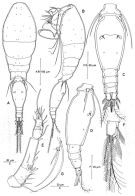 issued from : R. Böttger-Schnack in Mitt. hamb. zool. Mus. Inst., 1999, 96 [p.105, Fig.31]. Female (from Red Sea): A, habitus (dorsal); B, idem (lateral left side); C, urosome (dorsal); D, idem (lateral left side); E, A1; F, caudal ramus (dprsal, longest terminal seta omitted); G, P5 (dorsal). Nota: Proportional lengths (%) of urosomites and caudal rami 7.0:57.2:7.7:7.4:12.2:8.5. Relative lengths (%) of segments of A1 measured along posterior non-setigerous margin 6.4:20.4:45.2:12.9:3.8:11.3. Anal somite slightly wider than long, 1.4 times longer than caudal rami.
|
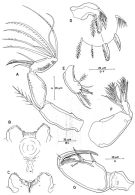 issued from : R. Böttger-Schnack in Mitt. hamb. zool. Mus. Inst., 1999, 96 [p.106, Fig.32]. Female: A, A2 (posterior); B, labrum (anterior); C, idem (posterior); D, Md (showing individual elements); E, Mx1; F, Mx2; G, Mxp.
|
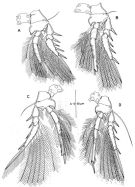 issued from : R. Böttger-Schnack in Mitt. hamb. zool. Mus. Inst., 1999, 96 [p.108, Fig.33]. Female: A, P1 (posterior); B, P2 (anterior); C, P3 (posterior); D, P4 (anterior).
|
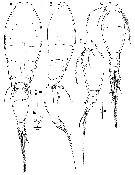 Issued from : K. Cho, W.-S. Kim, R. Böttger-Schnack & W. Lee in J. Nat. Hist., 2013. [p.27, Fig.11]. Female (10°30'N, 131°20'W): A, habitus (dorsal); B, habitus (lateral); C, urosome (dorsal; D, urosome (lateral); E, P6. Scale bars in µm. Nota : Exoskeleton heavily chitinized, entire surface covered with numerous deep pits as exemplified for genital double-somite (fig.13D, E). Prosome 1.6 times length of urosome, excluding caudal rami, about 1.5 times urosome lenth including caudal rami. P2-bearing somite without dorsoposterior projection in lateral aspect. Integumental pores on prosome as indicated in fig.9A, B. Pleural areas of P4-bearing somite with small pointed posterolateral corners. Genital double-somite 1.7 times as long as maximum width (measured in dorsal aspect) and 1.9 times as long as postgenital somites combined, with oval-rounded form ; exoskeleton heavily chitinized (fig.13D, E), largest width measured at about 2/5 distance from anterior margin, lateral margins rounded, posterior part tapering gradually. Paired genital apertures located at about 2/5 distance from anterior margin of genital double-somite ; armed with 1 spine an a minute spinule (fig.9E and arrowed in fig.13C). Secretory pores on dorsal surface as in fig.9C. Anal somite slightly wider than long, about 1.5 times longer than caudal rami. Caudal ramus about 1.4 times as long as wide. P5 with long plumose outer basal seta, about 2 times longer than outer exopodal seta, reaching far beyond genital apertures and extending as far as 4/5 the lengrh of genital double-somite (fig.9D, 13E). Exopod a free segment, about as long as wide0 bearing short spiniform seta and much longer slender seta, reaching as far as genital apertures ; both setae unornamented. P6 armed with 1 long spine and 1 minute spinule (fig.9 E, 13C).
|
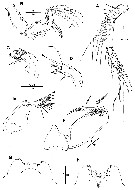 Issued from : K. Cho, W.-S. Kim, R. Böttger-Schnack & W. Lee in J. Nat. Hist., 2013. [p.26, Fig.10]. Female (NE equatorial Pacific): A, A1; B, A2 (posterior); C, Md; D, Mx1; E, Mx2; F, Mxp (anterior) and elements on inner margin of basis figured separately (insertion points of elements on basis indicated by stippled line); G, labrum (anterior); H, labrum (posterior). Scale bars in µm. Nota : A1 6-segmented. Armature formula as for T. pacifica. A2 3-segmented, relative lengths (%) of segments about 41 : 34 : 25. Surface of coxobasis covered with numerous deep pits, as on entire exoskeleton. Prpximal endopodal segment with double row of denticles on posterior inner margin. Distal endopodal segment with armature and ornamentation as in T. pacifica, except for absence of spinular patch on anterior face of distal endopodal segment.. Labrum similar to that of T. pacifica, except for number of 5 stout and 3 small dentiform processes medially along distal margin of each lobe. Anterior surface (fig.10H) with group of 3 secretory pores located on proximal part of each lobe and 1 additional on midregion. Md similar to that of T. pacifica. Mx1 similar to T. pacifica, except for slight differences in proportional lengths of elements, with middle element on inner lobe shorter than outermost element and innermost element on outer lobe shorter than the strong element next to the innermost. Mx2 similar to T. pacifica, except for seta on outer margin of allobasis not reaching as far as tip of allobasal claw. Mxp with surface of syncoxa sparsely ornamented with spinules. Basis with armature and ornamentation as in T. pacifica, except for fewer spinules between proximal and distal setae.
|
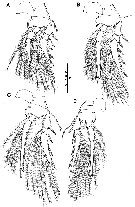 Issued from : K. Cho, W.-S. Kim, R. Böttger-Schnack & W. Lee in J. Nat. Hist., 2013. [p.27, Fig.11]. Female (NE equatorial Pacific): A-D, P1 to Ps (anterior voews). Scale bar in µm.
|
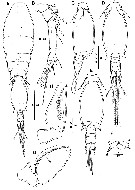 Issued from : K. Cho, W.-S. Kim, R. Böttger-Schnack & W. Lee in J. Nat. Hist., 2013. [p.28, Fig.12]. Male (10°30'N, 131°20'W): A, habitus (dorsal); B, A1; C, urosome (lateral); D, urosome (dorsal); E, urosome (ventral); F, P6, aberrant posterolateral cprner; G, Mxp (anterior); H, Mxp (medial view). Scale bars in µm. Nota : Caudal rami with length to width ratio as in female. Surface of genital somite covered with numerous deep pits. Secretory pores on dorsal surface as in figure 12D. Surface ornamentation on genital flaps and on ventral surface of anal segment not fully discernede, probably as indicated in figure 12E. A1 4-segmented ; armature formula as for T. pacifica. Mxp 3-segmented. Syncoxa unarmed, single secretory pore on inner distal margin, other surface ornamentation not discernible. Basis robust, with 2 small naked setae within longitudinal cleft, proximal seta slightly longer than distal one ; anterior surface with 1 to 2 transverse spinular rows in addition to row of short glat spinules along inner margin, without zmall expanded flap ; posterior face with 3 or 3 longitudinal rows of spatuled setules of graduated length (fig.12H). Swimming legs with armature and ornamentation as in female. P5 small exopod not delimited from somite, armature and proportional lengths of exopodal setae as in female ; outer basal seta about 1.4 times longer than outer exopodal seta, relatively shorter than corresponding seta in female. P6 represented by posterolateral flap closing off genital aperture on either side (fig.12 E) ; spinular pattern on surface as indicated in figure 12 E. Posterolateral corners distinctly pointed and protruding laterally so that they are discernible in dorsal aspect (Fig. 12A, D), occasionally with bifid tip (Fig.12F, arrowed.
|
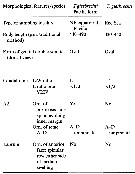 Issued from : K. Cho, W.-S. Kim, R. Böttger-Schnack & W. Lee in J. Nat. Hist., 2013. [p.16, Table 2]. Morphological characters of Triconia giesbrechti of the Triconia dentipes-subgroup from the north-eastern equatorial Pacific and The Red Sea. Nota: Orn: ornamentation; L: length; W: width; Compare with related species and form variants of the Triconia dentipes-subgroup from the north-eastern equatorial Pacific and from other regions: T. dentipes, T. pacifica, T. elongata, T. constricta.
|
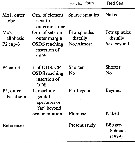 Issued from : K. Cho, W.-S. Kim, R. Böttger-Schnack & W. Lee in J. Nat. Hist., 2013. [p.17, Table 2 (Continued)]. Morphological characters of Triconia elongata of the Triconia giesbrechti-subgroup from the north-eastern equatorial Pacific. Nota: Orn: ornamentation; L: length; W: width; OSDS: outer subdistal spine; ODS: outer distal spine; CP: distal conical process Compare with related species and form variants of the Triconia dentipes-subgroup from the north-eastern equatorial Pacific and from other regions: T. dentipes, T. pacifica, T. elongata, T. constricta.
|
 Issued from : K. Cho, W.-S. Kim, R. Böttger-Schnack & W. Lee in J. Nat. Hist., 2013. [p.29, Fig.13, C-E]. Female (from NE equatorial Pacific): D-E, P5 and genital double-somite (dorsal and lateral, respectively); C, genital aperture, arrow indicating minute process close to spine.
| | | | | Ref. compl.: | | | Nishibe & Ikeda, 2004 (p.931, Tab. 2, 4, 5); McKinnon & al., 2008 (p.844: Tab.1); Nishibe & al., 2009 (p.491, Table 1: seasonal abundance); | | | | NZ: | 5 | | |
|
Carte de distribution de Triconia giesbrechti par zones géographiques
|
| | | | | | | Loc: | | | S Red Sea, G. of Aden, Australia (North West Cape), Japan (Tosa Bay, Oyashio region), NE tropical Pacific | | | | N: | 5 | | | | Lg.: | | | (810) F: 0,45-0,42; (1166) F: 0,44-0,49; M: 0,360-0,414; {F: 0,42-0,49; M: 0,360-0,414} | | | | Rem.: | épipélagique
Voir aussi les remarques en anglais | | | Dernière mise à jour : 05/02/2015 | |
|
|
 Toute utilisation de ce site pour une publication sera mentionnée avec la référence suivante : Toute utilisation de ce site pour une publication sera mentionnée avec la référence suivante :
Razouls C., Desreumaux N., Kouwenberg J. et de Bovée F., 2005-2025. - Biodiversité des Copépodes planctoniques marins (morphologie, répartition géographique et données biologiques). Sorbonne Université, CNRS. Disponible sur http://copepodes.obs-banyuls.fr [Accédé le 29 octobre 2025] © copyright 2005-2025 Sorbonne Université, CNRS
|
|
 |
 |












